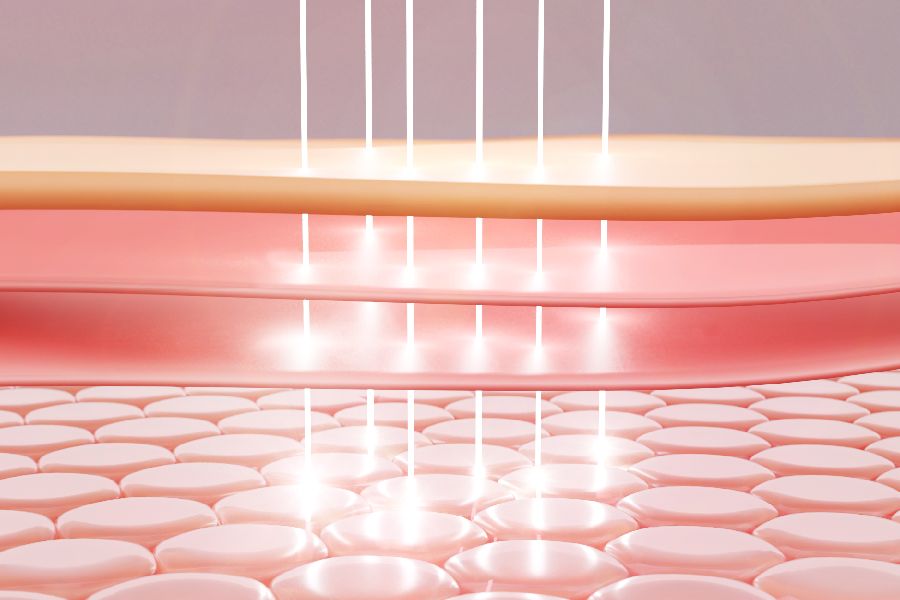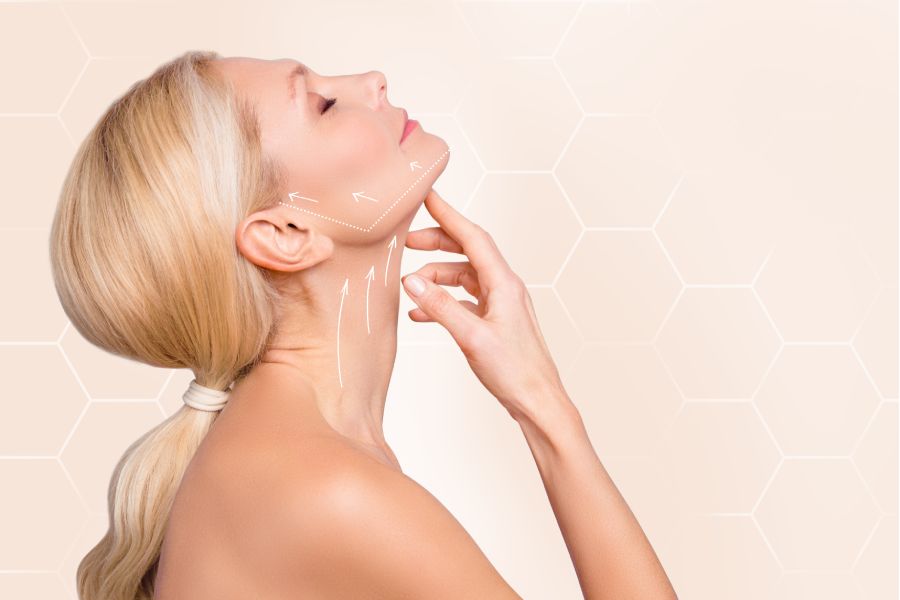As you age, your face and neck muscles weaken, allowing your skin to become saggy due to a loss of elasticity. This is the time when you look at yourself in the mirror and wish you could tighten your face and neck as with a ponytail. Luckily, that exists. This article will explain what a ponytail facelift really is.
Ponytail facelift is not a medical term but rather a marketing term for a procedure that has become globally popular. Stay tuned to learn everything you need to know about ponytail facelift.

Source: shutterstock.com / Photo Contributor: VK Studio
What Is a Ponytail Facelift?
A ponytail facelift is a cosmetic, minimally invasive surgical procedure that gives your face a tightened, lifted look as when your hair is in a ponytail. People are wowed by this procedure for various reasons including its fast results, minimal downtime and of course the catchy name.
This procedure is less invasive than how facelift surgery is done because it is performed by creating small hairline incisions. It is not around your ears, as with the regular procedure. Moreover, you can wear your hair in a ponytail shortly after the procedure without having visible scars.
The ponytail facelift tightens a person’s face by pulling the cheeks, forehead, and eyebrows upward. It is important to know that the surgeon does not remove any skin during this process. Therefore, this type of facelift is best for someone who shows minimal signs of aging. Best results occur with little excess skin on the upper neck and around the jawline.
All in all, the right patient can get tightened, rejuvenated skin on the face and neckline with this procedure.
Facial anatomy
The first thing you should familiarize yourself with is the facial anatomy and the anatomy of facial aging. Once you know that, you can understand how the ponytail facelift gives a natural, rejuvenating effect.
Our face has five concentric layers. Their consistency differs based on the different parts of the face.
- The first layer is skin which is thickest around the nose and cheeks and thinnest around the temple and eyelids.
- The second layer is fat that is found bulging by the cheeks.
- The third layer is a muscle layer that allows us to talk, smile, open and close our eyes, etc.
- In the fourth layer are our ligaments, vessels, and facial nerves. The ligaments hold all three previous layers.
- The fifth layer is the cheek and jawbones. All the facial anatomy resides in these bones.
Anatomy of facial aging
With age, all five layers lose elasticity, muscles become loose, and fat accumulates. Moreover, the ligament that holds the layers becomes weak, resulting in nasolabial folds and loose skin.
The ponytail facelift is supposed to lift the third and fourth layers, enhance skin tone, and lift the upper face and neck. Therefore, the final result should be a rejuvenated look.

Source:shutterstock.com / Illustration Contributor: atk work
What Does the Ponytail Lift Encompass?
Now that we know what a ponytail facelift represents, let’s see what it entails. As with many other plastic surgeries, this type of facelift entails pre-operative preparation.
How long does this approach take? The ponytail facelift is not a textbook facelift surgery. It is important for you to talk with your surgeon about your wishes and have reasonable expectations. The procedure is done under local anesthesia, and can take anywhere from one to four hours.
Is the procedure painful? You might experience a little pain and discomfort. If you experience bruising, it is likely to clear after ten days.
Doctor’s preparations include advice about food, drinks and supplement intake. It is recommended that you refrain from smoking for at least a few weeks before surgery. Also drinking alcohol or taking certain supplements may cause excessive bleeding. Remember, having a healthy weight and not eating the night before surgery is very important.
But food intake after surgery can also benefit your postoperative effects. It’s essential to understand that advance preparation is also vital for the recovery process.
How Long Does the Recovery Take?
Most patients have swelling and bruising for one to two weeks. Guidance after surgery is intended to acquaint you with the necessary measures for a smoother and swifter recovery. It is recommended to be careful with combing your hair around the incision area. Avoid dyeing your hair for at least the next two weeks, and use a gentle shampoo.
The majority of individuals resume their regular activities within a couple of weeks following a facelift. However, they may experience bruising and swelling near the incision areas. Delicate massages and cold compresses could provide relief during this period of sensitivity. You can get back to strenuous activities and normal life after two weeks. However, the complete healing process usually takes one to three months.
Remember that during the healing process, you should:
- Apply sunscreen – applying sunscreen helps avoid skin discoloration;
- Avoid stressing the affected area – do not wear your hair in a ponytail or go to the spa; avoid anything that might add additional stress to the area surrounding the incisions;
- Get plenty of fluids – drinking water, fruit juices, or teas is essential for eliminating toxicities and hydrating your skin;
- Take your medications – take the prescribed medications for pain and stiffness.
Benefits and Drawbacks of Ponytail Facelift
Now, we will see the advantages and disadvantages of a ponytail facelift. It is worth mentioning that the ponytail facelift is generally preferred over the traditional facelift procedure.
Benefits of ponytail facelift
Short recovery time
Compared to traditional facelift surgery, the ponytail facelift has less downtime. The healing process is relatively short, and the procedure is less invasive.
No alterations of the tragus
Usually, the traditional facelift modifies the front of the ear’s openings, called “tragus.” This is not the case with the ponytail facelift. Therefore, this procedure is not known to leave visible scars.
Durable effects
Besides being very long-lasting (the effects lasting from one to five years), the ponytail facelift should not disrupt the function of the skin.

Source: shutterstock.com / Photo Contributor: Roman Samborskyi
Possible risks of ponytail facelift
Infections and reactions to anesthesia
Same as with any other surgical procedure, there is a possibility of infection or adverse anesthesia reactions. That is why the treatment should be made with sedation anesthesia rather than with general.
Rare drawbacks
Other risks of a ponytail facelift include hematoma; however, this is known to occur in only 1.97% of the cases, and the doctor can remove it. If you are a smoker, you risk having a longer healing process and appearance of skin injuries.
Difference Between Traditional Facelift and Ponytail Facelift
You probably wondered how these two types of facelifts differ. The main difference is the area of the incisions.
A standard facelift leaves scars for a longer time on the scalp and around the ear. However, those spots allow surgeons to take off the extra skin, lift the lower part of the face, and make some improvements to the neck. A traditional facelift is a better solution for people with more advanced signs of aging.
On the other hand, these improvements can not be done with the ponytail facelift. Which implies the question – who is the best candidate for a ponytail facelift?
Who is the ponytail facelift best for?
If you tried fillers in the anti-aging journey and are unsatisfied with them, the ponytail facelift is your next step. You are the best candidate for the ponytail facelift if you want a more considerable outcome than fillers and botox.
People with early signs of aging will benefit from this procedure. They will get a lifted upper face, improved lower face, and reduced wrinkles around the eyes.
How Much Does the Ponytail Facelift Cost?
According to the American Society of Plastic Surgeons, the cost of a rhytidectomy or facelift varies depending on the state, the experience of the surgeon, and the type of facelift performed. Although the average price of a traditional facelift is around $8,000, this excludes anesthesia and surgeon’s fees, hospital or surgeon’s office fees, post-surgery garments, prescriptions, and medical tests. So the the ponytail facelift might cost anywhere from $8,000 to $30,000.

Source: shutterstock.com / Photo Contributor: RomarioIen
Bottom Line
If you have been wondering what a ponytail facelift is, now you have everything you need to know about it.
In a nutshell, a ponytail facelift represents a cosmetic surgery procedure that provides a mini lift for younger patients in order to get a rejuvenated look and tightened skin. The incisions placed in the hairline are barely noticeable.
The biggest advantage of this lift is the short healing time and no visible scarring.
However, it is always important to discuss with your plastic surgeon what irregularities bother you and decide mutually if the ponytail facelift or any other cosmetic procedure is right for you.
